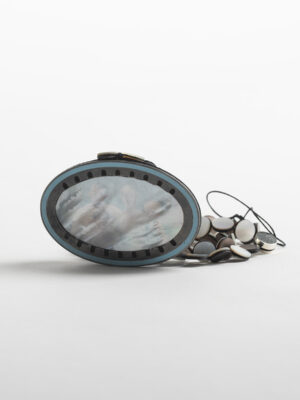advertorial
Since classical antiquity, the mutual fascination between the Orient and the Occident has repeatedly brought about new art forms. In the Art Deco period, for example, the ornamental exoticism of Persian miniatures or Japanese prints, of Chinese or Middle Eastern decorative arts lent themselves perfectly to fulfilling people’s desire for decorative and unusual luxury.

Also, the 1920s were characterized by technological progress and rapid societal changes, both of which were reflected in the jewellery and the arts of that era in the shape of flamboyant motifs and colours, wedded to clear-cut shapes and austere materials. The vanity and cigarette cases, clocks and watches from the Prince and Princess Sadruddin Aga Khan Collection bear eloquent witness to this. Having the privilege to showcase these resplendent pieces, created by the most prestigious Parisian jewellers, here at the Jewellery Museum — for the first time in its entirety in Europe — before they travel on to the Musée des Arts Décoratifs in Paris is a very special honour, says Cornelie Holzach, the museum’s director.



The collection originated when, on Christmas Eve in 1972, Prince Sadruddin gave his wife a superbly ornamented case by Cartier as a gift. This was the beginning of what evolved into the largest single collection, comprising 116 items, of Art Deco cases and timepieces. Most of them were made by Cartier, but they also include a number of creations by Van Cleef & Arpels, Boucheron or Bulgari, and they were all of them personal gifts that Princess Catherine received from her husband Sadruddin. In terms of their motifs, they constitute reified manifestations of the lively cultural exchanges between the East and the West. The Prince’s favourite themes were gardens, flowers, hunting and animals, particularly big cats.

One striking example is the ‘Panther’ vanity case created by Cartier in 1925, displaying a panther against a backdrop of cypresses, the most prevalent trees in Persian miniature landscapes, and crafted from enamel, mother-of-pearl, rubies, turquoise, onyx and diamonds. The panther might have also been inspired by the drawings of Paul Jouve, who had illustrated Rudyard Kipling’s Jungle Book. Compared to jewellery, vanity and other kinds of cases provided larger surfaces to accommodate reinterpretations of such exotic motifs. This masterpiece was showcased at the International Exhibition of Modern Decorative and Industrial Arts in Paris in 1925. In addition to cigarette and vanity cases, the Aga Khan Collection also comprises timepieces that incorporate masterfully crafted movements in exquisitely extravagant cases.



East Meets West — Jewelled Splendours of the Art Deco Era The Prince and Princess Sadruddin Aga Khan Collection
May 5, 2018 through January 6, 2019
At Pforzhem’s Jewellery Museum the collection is presented for the first time in its entirety in Europe. Prince Sadruddin, multilingual, and multicultural, worked for over forty years for the United Nations, serving as UN High Commissioner for Refugees for twelve years.
A magnificent book about the collection was published by Thames & Hudson in 2017 under the title of “Jeweled Splendors of the Art Deco Era. The Prince and Princess Sadruddin Aga Khan Collection”.
For more information, visit www.schmuckmuseum.de



